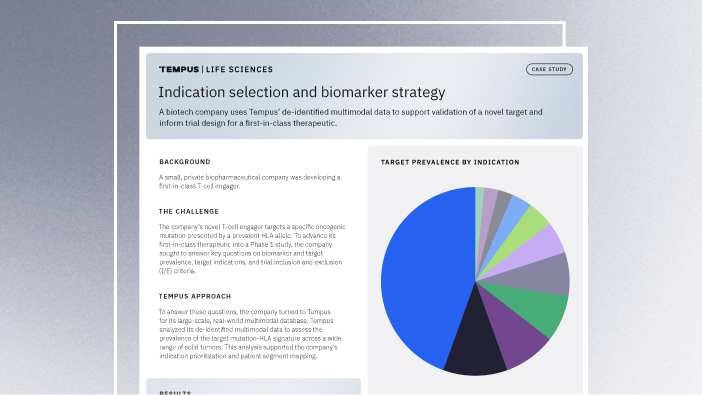-
PROVIDERS
New MRD Medicare Coverage for Select Indications*
*When coverage criteria are met. Additional criteria and exceptions for coverage may apply.
-
LIFE SCIENCES
REGISTER NOW
UPCOMING WEBINAR
Driving enterprise value with RWD -
PATIENTS
It's About Time
View the Tempus vision.
- RESOURCES
-
ABOUT US
View Job Postings
We’re looking for people who can change the world.
- INVESTORS
07/23/2025
Q&A: How Tempus applies AI for clinical research and patient care
Tempus leaders Chris Scotto DiVetta, SVP & General Manager of AI Applications, and Jonathan Ozeran, VP of Generative AI, discuss how the Tempus platform leverages AI and machine learning to support standard of care practices, helping providers adhere to clinical guidelines and drive insights that help refine clinical trial strategy.
Speakers
Jonathan Ozeran
VP, Generative AI, Tempus

Chris Scotto DiVetta
SVP & General Manager of AI Applications, Tempus

VP, Generative AI, Tempus
Chris Scotto DiVetta
SVP & General Manager of AI Applications, Tempus
The session explored how Tempus operationalizes a data-driven flywheel—from aggregating multimodal patient information to applying a sophisticated artificial intelligence engine and delivering insights that support clinicians and researchers. Their discussion highlighted how this approach is used to help streamline complex processes such as clinical trial matching and address the real-world barriers to adopting new technology in patient care.
Could you explain the core components of the Tempus platform, from data aggregation to the delivery of insights? |
Chris Scotto DiVetta: There are three components of the Tempus platform that are foundational to our software suite. The first pillar involves aggregating multimodal patient information from different sources, including electronic health records (EHR), laboratory information systems, image management systems, and picture archiving and communication systems. Unifying these fragmented data sources and structuring the information is critical to making it measurable for analysis. This ingestion, standardization, and data mapping layer form the basis of our platform, enabling Tempus to create a comprehensive, contextualized view of a patient’s clinical journey.The second pillar focuses on analyzing the aggregated datasets. Tempus’ teams of experienced data scientists and bioinformaticians analyze these vast datasets in collaboration with pharmaceutical companies and researchers to uncover critical insights used to develop novel therapeutics.The third pillar centers on delivering those insights to clinicians at the point of decision-making. To accomplish this, the Tempus platform provides tailored interfaces for multiple key stakeholders.For example, Tempus Hub serves as the physician’s interface, integrating these insights directly into their workflow through reports and other clinical decision-support tools. Tempus Lens is our dedicated platform for the scientific and research community, empowering users to analyze large-scale, de-identified patient data and test hypotheses to identify novel insights. The goal is to quickly generate evidence that can be used to accelerate drug development or advance academic research.Tempus Link and Next platforms also employ data analysis methodologies to support clinical decision-making. Both Link and Next utilize algorithms to analyze de-identified data in a continuous, surveillance-like manner, identifying patients who may be eligible for a clinical trial. Clinical trial inclusion and exclusion criteria are often complex and require information from unstructured clinical notes, and as such, these tools are designed to process unstructured data in near real-time and surface potential candidates for treatment. Additionally, Tempus Next codifies clinical care guidelines and monitors patient care to identify when an individual has deviated from guideline-directed care. By surfacing these instances, the platform creates an opportunity for providers to intervene and close care gaps.Ultimately, our approach is centered on a consistent framework: aggregating multimodal patient information, applying intelligence to analyze it, and then integrating the resulting insights back into the care continuum. This empowers clinicians and researchers with the data needed to make better, more informed decisions. |
Can you break down the AI-driven components of the Tempus platform that are developed for real-world clinical use? |
Chris Scotto DiVetta: One key component leveraged across Tempus applications is our suite of algorithmic diagnostics. These algorithms are developed by routinely analyzing contemporaneous clinical data to derive novel insights. For example, an algorithm might analyze this data to prognosticate a patient’s potential response to a specific therapy, as is the intended use of Tempus’ clinically-available Immune Profile Score, which prognosticates response to immune checkpoint inhibitor (ICI) therapy.One of Tempus’ specialties lies in end-to-end development of AI-enabled diagnostics. We first aim to identify and validate a novel insight. To drive clinical adoption, we then navigate the regulatory process, conduct clinical utility studies to substantiate our claims, and integrate the final tool into the physician’s workflow to support decision-making. We have a dedicated division focused on this entire lifecycle, embedding these algorithmic diagnostics into the various user interfaces we provide.We have also codified clinical guidelines into a set of components that are integrated across our applications and interfaces. This provides what we call ‘care pathway intelligence,’ which allows users to query medical context, such as guidelines for breast cancer patients, or access a comprehensive database of clinical trials sourced from public registries and our life sciences partners.Three core aspects underpin our applications. First, algorithms leverage historical patient data to generate insights that inform future care. Second, our codified knowledge bases deliver critical context, such as clinical guidelines and trial data, at the point of care. Third, Tempus One integrates the latest advancements in generative AI directly into these workflows. Together, these components form the foundation for the applications and use cases we support across the industry. |
Clinical trial matching is notably complex. How does the Tempus platform apply AI to streamline this process for researchers? |
Chris Scotto DiVetta: Our platform includes several features designed to improve clinical research. For instance, Tempus One’s ability to query unstructured data is critical for gaining a comprehensive understanding of a patient’s clinical context and determining their eligibility for a trial. This capability allows us to analyze vast amounts of unstructured information, such as clinical notes, to screen patients and identify specific cohorts. These functions are foundational to applications such as our trial matching service.Our clinical trial matching process is powered by a comprehensive database that serves as a single source of truth for trial eligibility criteria. The Tempus platform aggregates patient data and compares it against these criteria to identify potential matches. This culminates in a tool for providers that displays currently eligible patients and enables proactive monitoring through a watchlist of individuals who may become eligible upon disease progression. These features are examples of how we support providers and advance clinical research. |
Finding an eligible patient for a clinical trial is a critical first step, but it doesn’t guarantee enrollment. What are the challenges that prevent a match from becoming an enrolled patient, and how does Tempus address them? |
Chris Scotto DiVetta: In practice, we have significantly increased our capacity to match large volumes of patients to clinical trials, and this capability is continuously improving. However, a significant challenge remains in converting a ‘match’ into an enrolled patient, particularly in community settings. Historically, these sites may not have developed the necessary infrastructure to conduct clinical trials because they lacked a reliable way to identify eligible patients at scale.Now that identifying patients at scale is possible, the focus shifts to the next operational hurdle: building the capability to enroll them. The solution isn’t always technological; it often involves adapting workflows to leverage this new capability. This creates a ‘chicken and egg’ scenario. Technological advancement must come first to demonstrate the need for, and drive the adoption of, the necessary downstream operational capabilities.This is the challenge our TIME program addresses. We combine patient matching with services that support trial activation at the local site. This includes connecting the site with a sponsor to open the trial closer to the patient’s home, thereby facilitating enrollment. It is a service layer built upon our technology, designed to drive the desired outcome. This illustrates a key principle: technological progress does not automatically translate into improved outcomes. Addressing the operational and logistical challenges is equally critical to achieving the final goal. |
How is the Tempus platform architected to not only leverage current models but also adapt to future innovations? |
Jonathan Ozeran: For detailed information on our approach to embedding models and patient timeline analysis, we direct researchers to our publications, including those presented at ASCO, which are authored by our data science team.More broadly, our Agent Builder platform is designed to be flexible and configurable. We developed a toolset called AIR that enables the creation, hosting, and integration of various models. This framework supports existing foundation models, open-source models, fine-tuned models, and classical deep learning or machine learning models.We also recently announced a collaboration with AstraZeneca to build an oncology foundation model, and more details are available in our press release. This work is supported by Tempus’ extensive library, which includes approximately 300 petabytes of multimodal data. As technology evolves, the goal of Agent Builder, our agentic workflows, and Tempus One is to provide a scalable and well-governed framework for integrating these advancements. Governance is a central component, ensuring that we provide a robust, integrated, and secure solution, rather than a simple interface for a foundation model. |
| The successful application of AI in healthcare depends on more than just advanced algorithms. It requires a comprehensive platform that can aggregate and structure complex data, an approach to integrating insights into clinical workflows, and a commitment to solving the operational challenges that arise. To learn more about Tempus’ approach to solving these complex challenges and how we are working to accelerate research and improve patient outcomes, click here or contact us. |
Note: content edited for clarity.
|
-
11/11/2025
A new era of biopharma R&D: The TechBio revolution—realities and the next frontier
Join Tempus and Recursion leaders to explore their strategic TechBio partnership. Learn how they use AI and supercomputing with petabytes of data to accelerate drug discovery and development. See the impact on biopharma R&D's future.
Watch replay -
11/14/2025
Validating a novel target and informing trial design for a first-in-class therapeutic
Discover how a biopharma company used Tempus’ de-identified multimodal data to support validation of a novel target and inform trial design for a first-in-class therapeutic.
Read more -
11/14/2025
Guiding indication expansion with multimodal real-world data
Discover how a biopharma company used Tempus’ multimodal real-world data to guide its indication expansion strategy. See how our analysis of biomarker prevalence helped them identify new opportunities, prioritize R&D, and inform future trial design.
Read more


